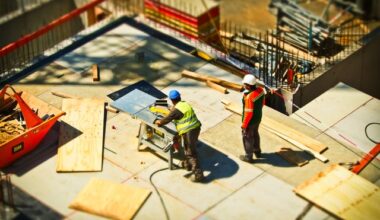Construction inspection is critical to the effective completion of a project. Inspection is required to meet industry standards for accuracy, quality, and keeping construction work on time and within budget, whether it is checking project requirements on-site or documenting changes to an existing plan. Routine construction site inspections are required to successfully administer proper checks on a construction site throughout the project’s lifecycle. In this post, we’ll look at what construction inspection entails and a checklist for inspection services.
What Is Involved in a Construction Site Inspection?
#1. Progress Inspection
A construction site inspection checklist is vital during the planning phase of a construction project since it ensures project requirements are met. Once the project has begun, progress inspections become part of the daily routine on the job site to ensure that these requirements are satisfied.
Progress inspections are carried out by one or more personnel from various trades, depending on the scale of the project. If a certain area of the project necessitates additional input, professional inspectors may be called in to do inspections on items such as the environmental policy, waste management strategy, and accessibility.
#2. Quality Control Inspections
Quality control inspections verify that the finished construction work fulfils the established quality requirements. In addition, quality inspections ensure that the project meets all of the specifications and quality criteria mentioned in the contract agreements. Regular site walkthroughs are part of quality inspections, and they usually result in a monthly quality report that identifies concerns and tracks improvement.
#3. Inspections for Building Regulation Compliance
Builders ensure that completed work will be approved by the local authority’s building control department or an approved inspector by conducting building regulation inspections. The number and frequency of these building code inspections vary depending on the specifics of the project.
These examinations are most commonly conducted during:
- Commencement.
- Extraction (before excavations are filled).
- The foundations (before they are covered up).
- The installation of damp-proof courses.
- Installing new drains (before covering up).
- Primary structure construction.
- Insulation installation.
- Roof construction.
- Completion.
When is a Construction Site Inspection Performed?
#1. Pre-Construction
While most construction site inspections take place during the construction phase, they can begin as early as pre-construction. Before construction begins, pre-construction inspections are performed to assess the state of the property and the surrounding areas. Checks on planning permissions, conditions, and obligations to ensure compliance with local authorities may be included in pre-construction site inspection checklists.
#2. Throughout the Project
Construction site inspections, as the name implies, take place on the construction site. During a construction project, the major metrics of quality are the project scope, budget, and schedule.
#3. Project Completion
The final inspection and construction closeout process includes site walkthroughs to ensure that everything was done in compliance with the contract agreements. The structure is ready for its intended purpose or occupancy once this is established. This indicates that the punch list has been finished, and all submittals, lien waivers, warranties, close-out papers, manuals, and as-builts have been turned over to the owner and checked for accuracy.
The Advantages of Construction Inspection Services
Here are five reasons why you should consider hiring construction inspection services for your next project.
#1. Success is in the details when it comes to delivery.
Each deliverable is precisely executed for the client if the contract is carefully reviewed and the agreed project scope is built out. To ensure that a project is delivered to customer expectations, detailed record-keeping and photo documentation are required.
#2. Inspections in real-time and immediate information exchange
Monitoring project information from the field via real-time data gathering improves reporting, processing speed, and data management. Modern tools enable real-time solutions that reduce danger to both clients and the wider public. Rapid information sharing and communication between the owner and contractor might be crucial in dealing with pressing issues.
#3. Infrastructure is designed to last a lifetime.
Building a solid framework is essential for any endeavour. Quality designs contribute to and help to establish safer communities. Quality construction inspection ensures that projects are completed on time and within budget throughout the design and constructability assessment process.
#4. Save money on future maintenance expenditures.
Construction inspectors supervise the job and are in charge of predicting risk, interacting with the contractor, and documenting progress as well as any construction or design issues for the owner.
Using GPS Rover, you may streamline inspection operations. GPS Rover technology may be used to increase efficiencies, track site coordinates, and measure any project. Inconsistencies are eliminated by uploading recorded field data and showing it on auto-generated plan sheets when utilizing GPS technology to track amounts.
Some Guidelines for Construction Inspection
As previously stated, the major quality measures of a construction project are the project scope, budget, and completion time. When organizing an inspection, always return to these three major themes.
#1. The project’s scope
The established scope of the construction project should always lead the inspection processes, with the client’s needs as the primary emphasis of the scope. All construction inspection checklists and construction reports must include the customer’s information, as well as detailed notes on the communication history between the client and your construction staff.
Everything that is changed or installed must be approved by your client. Any of your construction project checklists should prioritize communication with the client. Use construction inspections to ensure that everything is going according to plan.
#2. Budget
All of your money-related construction inspection checklists must always include a reference to the project budget. Another objective as a contractor or project manager is to complete a project on time and under budget, as this strongly reflects the quality of your job.
Make sure you have inspections to check supplier cooperation, material purchases, labour activities and payouts, and so forth. Use your construction inspections judiciously to ensure that all spending stays within budget as you move from one phase to the next and all the way to completion.
#3. Schedule
Your construction project timetable has a direct impact on your customer’s budget and needs, which can change a satisfied client into a dissatisfied one, resulting in costly litigation. Use construction inspections to keep track of your project’s progress on a daily, weekly, and monthly basis.
Any kind of delay should always be communicated to all key stakeholders, including their contact information. Construction delays can be costly; always adhere to the clearly specified project timeline from the outset of all construction activities.
Checklist for Construction Inspection
A construction inspection checklist serves as a road map for ensuring that construction adheres to federal and state regulatory and safety standards. It functions as a quality control tool for the construction sector and stakeholders.
- Inspections of work progress to ensure that it is in accordance with the plan and requirements
- Work quality inspections, as well as conformity with standards and specifications
- Paint and coating inspections
- Field testing includes a material sampling of soils, concrete, and asphalt, among other things.
- Examine and complete the change order/s
- Material delivery and use inspections
- After the building has been completed, semi-final and final inspections will be performed.
- Preparation of punch list(s) and monitoring of work completion
- Handover inspection to ensure a smooth project closure
What should a construction inspection checklist include?
Any construction project requires a construction inspection checklist to ensure appropriate execution and compliance. It should cover OSHA safety compliance standards, personal protection, preventive safety checks in the surrounding environment, machinery and equipment safety checklist, and so on.
Who and why utilize a construction inspection checklist?
The construction inspection checklist is used by construction site owners, contractors, construction supervisors, and inspectors to prevent construction site injuries, dangers, and fatalities. It outlines the methods and processes that must be followed in order to comply with federal and state construction norms and standards. Any construction project must be ensured to be efficient and safe.
What are the benefits of using a construction inspection checklist app?
When you use a construction inspection checklist software instead of a paper-based checklist, you can keep accurate, transparent, and thorough safety hazard data and take corrective steps. It ensures that your construction inspections are precise, thorough, and compliant.
You can accomplish any construction project fast and safely by using the construction inspection checklist app. You may make safety the number one priority in your construction project. So, you don’t have to spend hours compiling and transcribing paper-based construction inspection forms.
With a mobile app, you can hold the foreman remotely accountable for good site management and corrective actions, as well as provide complete documentation.
Errors in construction and alteration orders
In construction projects, human error and modification orders are unavoidable. The significance of construction inspection is based on a good inspection system that addresses faults and necessary modifications. A good inspection system centred on the interconnectedness of your project teams will aid in the success and on-time delivery of your construction project.
Make Use of Construction Site Inspection Software
Construction site inspection software can aid in the construction of your site inspection processes. Documentation, tracking, and communication are all aided by digital construction site safety inspection forms. Your teams can use construction site inspection software to create, administer, and maintain a company-wide inspection library. Standardization also enables you to establish a benchmark for your current procedures, identify issues, and enhance your entire quality and safety program.
Salary of a Construction Inspector in the United States
What is the average salary for a Construction Inspector in the United States? As of, the average Construction Inspector’s salary in the United States was $53,882, with a salary range of $44,348 to $65,188. Salary ranges can vary greatly depending on a variety of things, including schooling, certifications, supplementary talents, and the number of years you have worked in your field.
Why Are Inspections Important In Construction?
Inspections on construction sites are essential for ensuring that quality and safety protocols are implemented appropriately from the start. Construction projects necessitate the coordination of several project team members, supplies, and equipment, which exposes contractors to numerous risks and dangers.
Conclusion
Every construction project involves some level of risk. Construction site inspections assist to reduce some of that risk by providing a procedure for teams to deal with human error and unplanned changes that occur throughout the project. Having a detailed checklist for construction site inspections will help drive the project’s successful completion and provide visibility into areas for improvement. As a result, teams may keep ahead of safety challenges while leaving risk behind.
Construction Inspection FAQs
What is the importance of having inspections?
Inspections are crucial because they allow you to: listen to workers’ and supervisors’ concerns. improve your understanding of jobs and duties Identify current and potential hazards.
What is done during site inspection?
Site inspections are a series of frequent actions designed to assess and verify on-field compliance, such as Safety Standards, working conditions, and other essential aspects of the worksite. The site inspection is being carried out utilizing traditional methods of field inspections with a pen and paper checklist.
What are the four types of inspections?
The FDA conducts four types of inspections: pre-approval inspection, routine inspection, compliance follow-up inspection, and “for cause” inspection. Each is meant to help safeguard the public from harmful items, but the focus and expectations of each sort of inspection differ.
What is a checklist in construction?
Construction checklists provide particular information about your project’s activities and phases. Construction checklists can more precisely categorize specific things, supplies, equipment, jobs, and so on. They simplify complex tasks by breaking them down into basic actionable components.
What are the four phases of inspection?
The four phases of inspection are sensitization, pre-inspection, inspection, and quality assurance.






